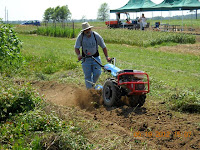Summer has arrived with a vengeance. We have seen temperatures in the low 100's over the past two or three days, and there does not appear to be a break until at least mid-week. The long-term forecast indicates average temperatures in July estimated at 95 degrees, with an average rainfall of 3 inches. This may alter our watering plans for the test garden.
Saturday Donald and David planted cucumber, watermelon, and more corn. Most of the planting was in Section 3 with the exception of the watermelon. Many years ago we planted watermelon and cucumber in our backyard in Southern California. While we produced large watermelons, they had absolutely no taste, which we attributed to planting them too close to the cucumber. Taking this lesson to heart, we tilled a small patch off to the side of Section 2 and planted our watermelon separately.
Next week we hope to complete planting, with the final seeds being a different variety of watermelon (which will be planted in its own patch off to the side of Section 3), pumpkin, and beans.
We planted onion in Section 2 earlier this month, but have not had any emergence at all. The seed should have been planted by April, so we knew it may not germinate. It didn't, so we will be planting the beans over the onion (in Section 2). Section 3 will end up being primarily pumpkin and tomatoes (if they ever start growing).
We will most likely replant the corn in Section 1 as it is still not doing well. We plan on re-tilling the ground and will do a full-till rather than strip tilling. We have some sunflowers growing so we will try to preserve those. In addition, we will be planting more sunflowers.
As a recap, we have planted the following vegetables:
Section I (Northern Section)
- Luscious Hybrid (the only Hybrid we have planted, but it is still Organic) Sweet Corn - four 30-foot rows planted north to south onMay 28th. Poor emergency so we will be replanting.
- Mammoth Sunflower - Planted on both outer edges of the corn on May 28th. We have had good emergence on the western edge, but poor emergence on the eastern edge, and what did emerge is now gone (possibly from insects or animals). We will be replanting the eastern edge after the corn is replanted.
Section II
- Black Beauty Zucchini Squash - eight hills planted on June 10th. Good emergence, good growth as of today.
- Evergreen Bunching Onions - Two rows planted East to West on June 10th, planted two months too late. No emergence. Will be replaced with Kentucky Wonder (Pole) Beans.
- Scallop White (Bush) Squash (also known as Patty Pan) - three hills planted on June 16th. Emergence has been good and we have good growth as of today.
- Moon & Stars Watermelon - five hills planted June 23rd. This "watermelon patch" is off to the west side of Section 2.
Section III
- Luscious Hybrid Sweet Corn - Planted four rows east to west on June 16th. Have emergence, better than Section one but growth is mediocre.
- Sumter Cucumber - five hills planted June 23rd.
- Luscious Hybrid Sweet Corn - four rows planted east to west on June 23rd.
Section IV (Southern Section)
- Cherokee Purple Tomatoes (Heirloom) - Transplanted May 28th. No change since transplanting.
As you can see, we have a good variety, and most of the seed was planted within acceptable time ranges (though at the far end). Overall, we did better at getting seed down then we expected.
Currently we are watering every 7-days; however, depending on the weather, we may go to every 5-days.
Donald and David cleared more of the east fence line and hope to have the work done within the next two weeks. Donald is already working on the process for obtaining soil samples, and this process will begin once the fence line is complete and the main plots marked out. Once the soil sample reports are returned, planning for winter cover crops will start.
As Baker Heritage Farms hopes to have year-round production in the future, plans are already underway to determine the next steps. Depending on how the test garden does through the summer, a winter crop may be planted. Most viable winter crops for this area are root crops and crops that grow low to the ground. We will have to evaluate whether or not root crops are worthwhile based on the rock content of our soil. Animals are a concern with the low profile crops and we expect to learn more about animal risks with what is already planted.
We hope we have devised a way to keep dogs out of the chicken coop and will be working on getting the fence up and the hen house finished in the next couple of weeks.
Until next week,
Blessing to all from Baker Heritage Farms





